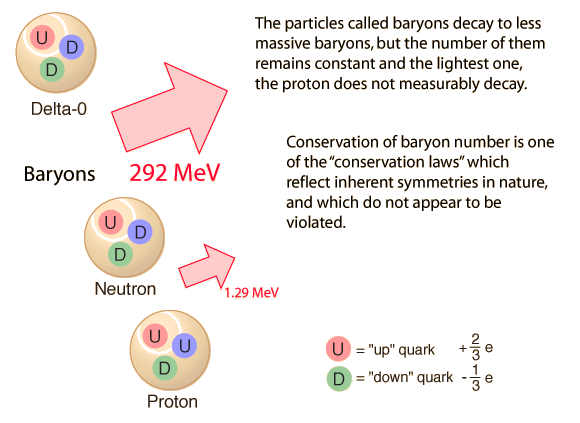The Conservation of Baryon Number


Just like water running downhill, it is a general observance that particles and systems will move spontaneously from a high energy state to a lower one. For the variety of particles that we have observed in the universe, this principle plays out in the decay of particles. In general, a particle will decay to another particle or particles if in doing so it can lower its energy. In the world of small particle decay, this general tendency is often stated as the "totalitarian principle" which is something like "if it can happen, it will". If a heavy particle seems to have a way to decay into a lighter particle or particles but it is not observed to do so, then there must be some reason why it can't. Observations have then led us to rules for decay which can be stated as conservation laws or symmetries of nature. One of the conservation laws that we find is the conservation of baryon number, and it has had a profound effect on the nature of the universe. Baryons include the proton and the neutron as the lightest baryons, and then a large family of heavier baryons which will generally decay to neutrons and protons, like "water running downhill".
As a constraint on the early big bang, the conservation of baryon number had a major effect on the nature of the universe. This observed conservation law says that the number of baryons remains constant, and this was a crucial constraint that helped in the building of detailed models of the big bang. Practically, it meant that all the heavy baryons that existed in the very hot early stages decayed to produce neutrons and protons but the total number of baryons remained constant. As the lightest baryon, the proton did not decay because to do so would be to violate the conservation of baryon number - there was no baryon lighter that it could decay into. This contributed the relative stability of producing a collection of protons and neutrons from which the visible universe could be constructed.
It should be said that current theoretical models suggest that the proton should actually decay with an extremely long lifetime, and experiments have been conducted to try to detect that decay. The proposed decay is a part of the grand unification model for the fundamental forces, but the decay lifetime is so long (orders of magnitude longer than the age of the universe) that it plays no role in the early stages of the big bang.
| The division of particles into fermions and bosons |
HyperPhysics  | R Nave |